Making a great podcast goes beyond just good audio; audience involvement depends much on video quality. Whether you're creating solo episodes, live-streaming conversations, or interviewing a good podcast camera guarantees your material looks professional.
Given the variety of choices available, choosing which podcasting camera fits your needs might be taxing. Which would you choose—a DSLR or a webcam? Does one absolutely need a 4K camera? Should you also take into account any additional podcast camera setup basics?
This article dissects the best podcast video cameras, crucial elements to look for, and the best techniques to make your podcast aesthetically pleasing. It will guide you in making a wise choice whether your budget is limited and you are a novice searching for a reasonably priced solution or an experienced podcaster ready to upgrade to a high-end camera.
Top Features to Look for in a Podcast Camera
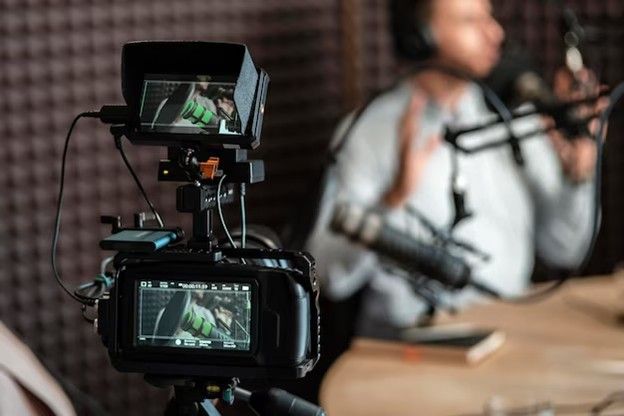
The professionalism and appeal of your material will be much enhanced by selecting the appropriate podcast camera. Although a superb podcast's foundation is audio, viewers' attention is kept by visual quality. Knowing the main characteristics of a podcast video camera will enable you to make the best decision whether your setup is being upgraded or you are just starting out.
Resolution: Why 1080p and 4K Matter
Regarding video quality, resolution is absolutely crucial. To provide sharp images, a decent podcast camera system should enable at least 1080p (Full HD) quality. 4K resolution is the approach to stand out and future-proof your material. It offers additional details, which sharpens your podcast even on bigger screens.
A recent poll indicates that more than 80% of the video content consumed online is in HD or above, reflecting the expectations of viewers for first-rate images. Should your camera be only 720p, it may not hold up against rival podcasts providing flawless 4K footage.
Frame Rate: Smooth Video for a Professional Look
Have ever seen a video that seems strange or jerky? That occurs with a too low frame rate. For a seamless, naturally looking video, the finest podcasting cameras provide at least 30 frames per second (fps). Some excellent cameras for a video shoot at 60 fps will help to create fluid and lifelike movement, therefore enhancing the even more cinematic quality.
Most professional podcast cameras give greater frame rates top priority, particularly when capturing interviews where facial expressions and hand movements count. A sluggish video can divert your viewers and provide your material less polished impression.
Low Light Performance: Guaranturing Quality in Various Lighting Environment
Not every podcaster boasts a fully furnished studio with ideal lighting. Low-light performance is, hence quite vital. More light may be caught by a camera with a bigger sensor and wider aperture, therefore lowering graininess in dark surroundings.
If you record in natural light, where conditions vary over the day, this function is very vital. Certain of the best webcam for podcast changes automatically to low light, maintaining balanced and clear video. Without this, viewers may find it difficult to concentrate on your material as film may be either overly dark or noisy.
Autofocus and Zoom Features for Flexibility
One of the most annoying cameras is one that struggles continuously to keep you in focus. A podcast video camera depends on good autofocus, particularly if you walk about while talking. Fast, exact autofocus cameras guarantee that you remain sharp free from image blurring in and out.
Optical zoom changes things for people filming demonstrations or interviews. Optical zoom preserves clarity while bringing your subject closer than digital zoom, which merely cuts the image and lowers quality. Whether your setup requires a wide-angle view or a close-up photo, a 10X optical zoom lets you be flexible.
Connectivity: USB vs. HDMI for Easy Setup
Convenience and quality can both suffer depending on how you link your camera to your recording configuration. Starting users will find USB cameras perfect since they are plug-and-play. If you have a webcam, direct streaming usually best uses a USB connection.
But HDMI cameras offer more control over your recording settings and improved image clarity for higher quality video. For a cleaner, more cinematic image, many professional podcasters employ DSLR-quality optical streaming cameras with HDMI output.
Thanks to their better video quality, almost 65% of video podcasters say they prefer cameras with HDMI output. Investing in an HDMI-compatible camera will greatly improve your production value if you take podcasting very seriously.
Best Cameras for Podcasting
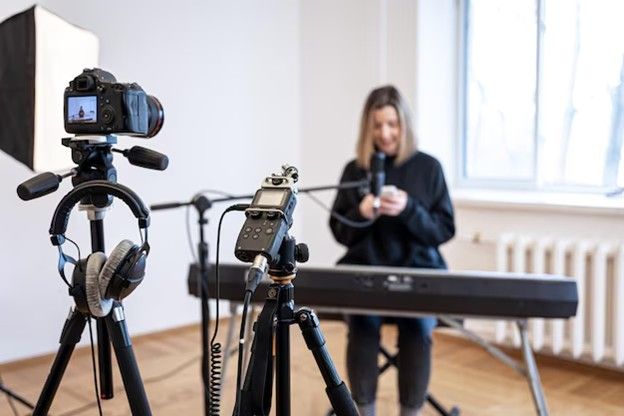
Knowing the strengths of various cameras will enable you to choose the correct fit for your podcast camera configuration.
1. DSLR and Mirrorless Cameras for Podcasting
Professional podcasters especially like DSLR and mirrorless cameras since they have interchangeable lenses and outstanding video quality. For those who wish their podcast to look polished, studio-like, these cameras provide a cinematic image.
Among the greatest choices are the Canon EOS M50. It produces clear footage with 1080p at 60fps and 4K at 24fps. Even when you move around speaking, the Dual Pixel Autofocus keeps you in focus. Mirrorless cameras such as the M50 also have a small footprint, which facilitates setup over conventional DSLRs.
2. Webcam Options for Podcasters
A webcam is the finest choice if you search for a plug-and-play fix. Perfect for livestreaming podcasts, web cameras are simple, reasonably priced devices. They don't call for additional software or capture cards; they connect via USB.
One often-used choice is the Logitech C920. If you have several individuals on camera, its wide field of view and 1080p footage at 30fps make perfect records. For improved colour accuracy, the Logitech Brio—which supports 4K resolution and HDR—is another excellent option.
3. Camcorders for Podcasting
For podcasters who record several episodes at once, camcorders are a dependable choice since they are made for extensive recording sessions. Camcorders run constantly without interruption unlike DSLRs, which have recording restrictions because of overheating.
One good option is the Panasonic HC-V180K. If you ever have to record handheld, this boasts image stabilisation, excellent optical zoom, and 1080p HD capability. Because they are light, camcorders are simpler to carry around than large DSLRs.
4. 4K Streaming Cameras
A 4K streaming camera is the way to go if you wish the greatest possible video quality. These cameras guarantee that your audience may view every detail since they are designed for high-end live streaming.
Among the best options in this range is the Sony Alpha a6400. Having one of the fastest autofocus systems available, it records 4K video at 30fps. This implies that even if you move about, you will always remain sharp on camera. Monitoring yourself whilst recording is also much improved by the flip-up screen.
Combining DSLR-level optics with streaming capability, streaming cameras such as the Nearstream VM20 go one step further. Unlike conventional DSLRs, they are designed to run extended recording sessions producing professional-grade video.
5. Dedicated Podcast Cameras (Podcast Video Cameras)
Dedicated podcast cameras are the finest choice for podcasters who wish for a basic, all-in-one camera. Designed for video creators, these cameras provide built-in streaming, AI-powered framing, and Portable Audio Mixer.
One instance would be the Logitech StreamCam. It records in 1080p at 60fps, giving videos a polished, businesslike appearance. The Mevo Start is another excellent option meant especially for livestreaming podcasts. It allows wireless streaming, hence there is no complex setup required to begin live.
Building the Perfect Podcast Camera Setup
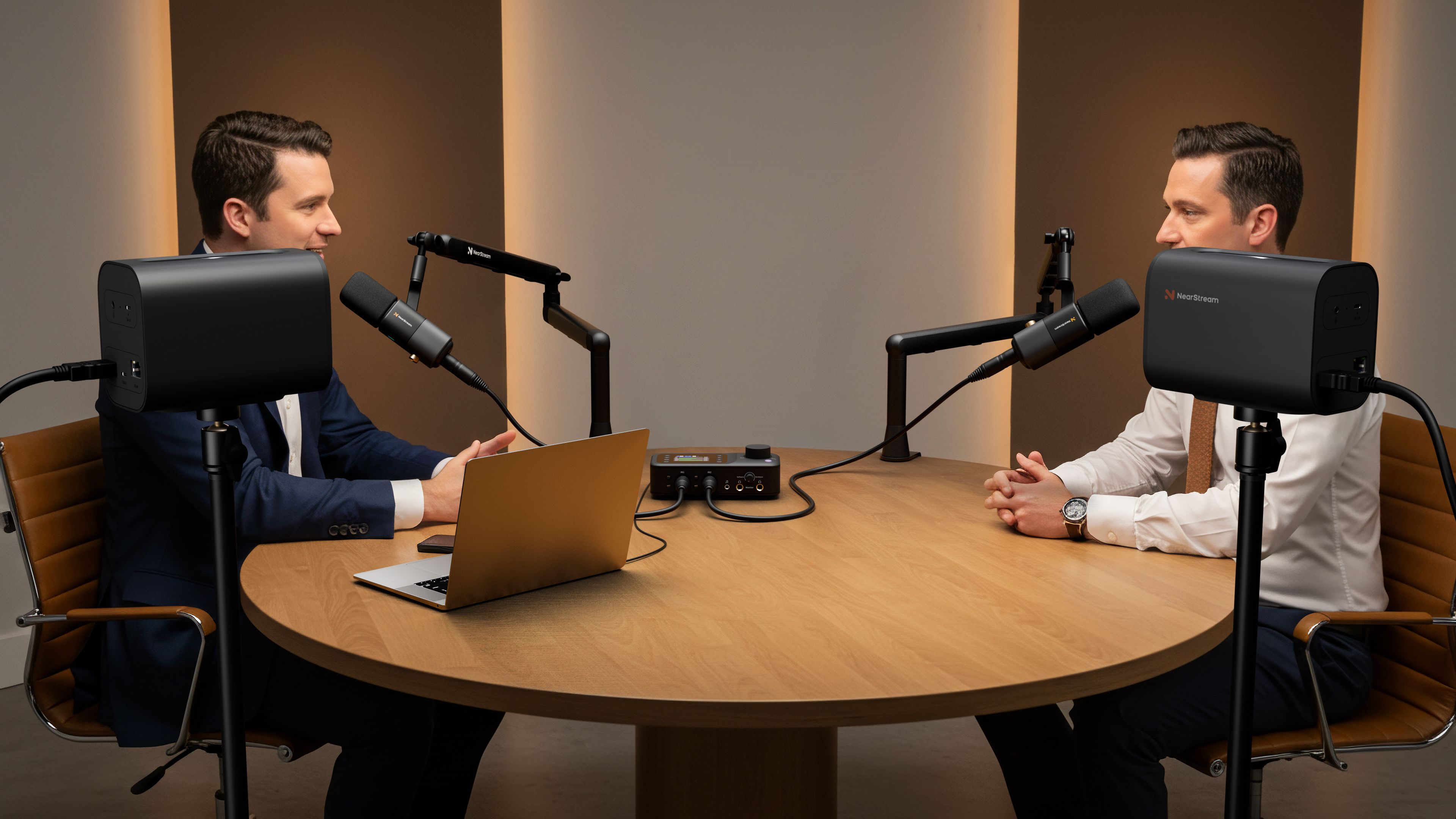
A podcast camera system is about developing a professional workflow that improves video and audio quality, not only about choosing a camera. From selecting the appropriate podcast camera to maximise lighting, audio, and software, every element contributes to make your material interesting.
Choosing the Right Camera for Your Podcast Needs
Your format, budget, and audience involvement goals will determine the best podcasting camera. Great for novices, webcams such as the Logitech Brio have 4K resolution. While streaming cameras like the NearStream VM20 mix DSLR optics with live streaming capability, DSLRs and mirrorless cameras offer cinematic quality. Studies reveal that sixty per cent of podcasters replace their cameras in the first year in order to improve retention and quality.
Additional Equipment for a Complete Podcast Setup
Beyond the best camera for podcasting, correct lighting, audio, and stability improve production value. While great cameras for video such as the NearStream AM series guarantee clean sound, softbox or ring lights improve clarity. For dynamic shows, wireless mics provide mobility. Tripods and stands help to avoid wobbly video, therefore ensuring a professional appearance from the podcast video camera.
Video Editing and Streaming Software for Your Podcast
Software for editing and streaming helps polish your work. OBS Studio is a free recording tool; advanced editing is offered by Final Cut Pro and Adobe Premiere. Ecamm Live presents direct broadcasting and multi-camera switching for live streaming. Live video podcasts show 27% more interaction than pre-recorded ones, so software is rather important for audience retention.
Best Practices for Using Your Podcast Camera
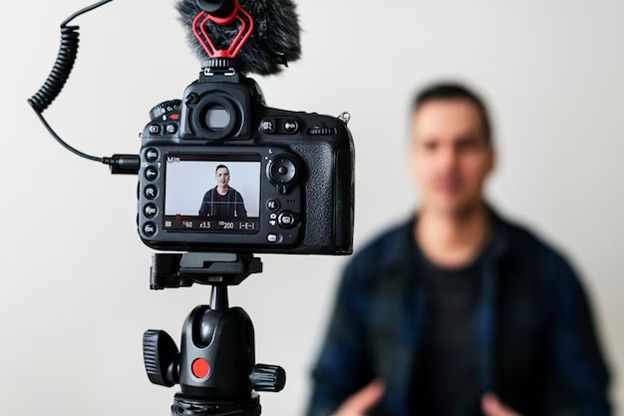
A podcast camera is only as excellent as your usage of it. Professional, high-quality video that keeps your viewers interested is guaranteed by correct positioning, lighting, and camera settings.
How to Position Your Camera for Optimal Framing?
Your podcast camera should be positioned at eye level to seem natural and attractive. Appealing visually and helping to balance the shot is the rule of third. An excellent camera with a wide-angle lens guarantees everyone stays in the frame free from distortion in multi-host configurations.
Setting Up Proper Lighting for Clear Video
Correct illumination is essential even for the best podcast cameras. Soft, equal illumination is guaranteed by a three-point lighting arrangement including a main light, fill light, and backlight. Should room be limited, a ring lamp or softbox offers professional-grade illumination. Studies reveal that well-lit videos increase viewer retention by 32%, thus lighting becomes quite important for your podcast camera arrangement.
Adjusting Settings for the Best Picture Quality
Your podcast video camera output will improve with the optimisation of the resolution, frame rate, and exposure. A 30 fps frame rate provides fluid animation; clarity is guaranteed by 1080p or 4K resolution. Changing shutter speed and ISO fine-tunes brightness and sharpness, so producing a finished, studio-like appearance.
Testing Your Camera and Equipment Before Recording
Testing a recording before it goes live helps avoid typical technical problems. Programs like OBS Studio or Ecamm Live let you preview lighting, sound, and frame. Studies show that pre-recording testing reduces mistakes by 45%, thereby guaranteeing a flawless and professional podcasting experience.
Frequently Asked Questions About Podcast Cameras
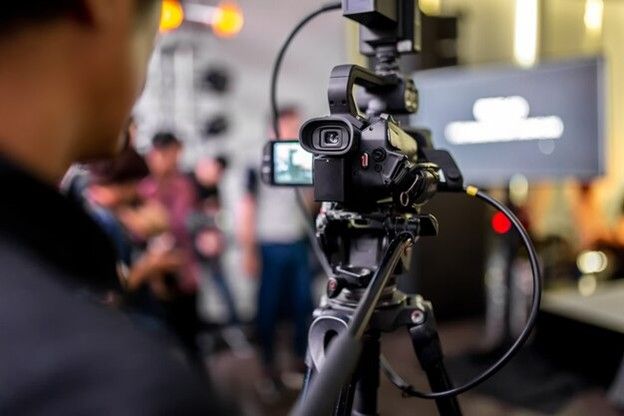
What’s the Difference Between a Webcam and a DSLR for Podcasting?
Simple setups benefit much from webcams, which are also rather user-friendly. With 4K resolution and auto-focus, the Logitech Brio webcam is the ideal one for podcasting. Professional-looking podcasts would find DSLRs, such as the Canon EOS M50, perfect for depth, detail, and low-light capability.
Can I Use a Regular Camera for Podcasting?
Indeed, but within restrictions. Many basic cameras lack long recording times, crisp HDMI output, and external microphone capability. It might not be best if your camera overheats or stops recording after thirty minutes. Better dependability comes from investing in a specialised podcast video camera such as the NearStream VM20.
What’s the Best Budget Camera for Podcasting?
Starting with 1080p resolution, the Logitech C920 camera is a fantastic tool for novices. The Sony ZV-1 boasts outstanding autofocus and built-in live-streaming capabilities if you wish for greater quality. The NearStream VM33 provides professional-grade video free of unnecessary accessories for a dedicated streaming camera.
Do I Need a 4K Camera for My Podcast?
4K future-proofs your material but is not a necessary. Although most consumers only need 1080p, 4K HD cameras such as the Sony Alpha Alpha a6400 or NearStream VM20 offer outstanding detail and lifetime. If live broadcasting, think through storage and bandwidth requirements before committing to 4K resolution.
How Do I Stream Live with My Podcast Camera?
Your podcast camera setup calls for a camera with clean HDMI output or USB&XLR Condenser Microphone functionality if you are stream live. The easiest are webcams; DSLRs and streaming cameras provide better quality. Programs such as OBS Studio and Ecamm Live enable flawless live streaming together with skilled customising.
Final Thoughts: Finding the Right Camera for Your Podcast
If you're starting, a webcam or entry-level streaming camera is a great choice. Upgrading to a DSLR or 4K streaming camera enhances the quality when your podcast gets going. Podcasting calls for a camera that complements your workflow and content style.
Making the Most Out of Your Podcast Setup
A professional setup consists in more than just a single video camera. Correct illumination, sound, and stability improve output quality. A polished appearance comes from matching your podcasting camera with soft lighting, top-notch mics, and a strong tripod.
A stronger audience connection is created by proper podcast camera placement. Whether you decide on a high-end 4K camera or an inexpensive webcam, your podcasting experience will improve with informed choice.






































































